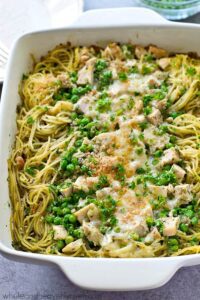Potato Gnocchi with Fresh Herbs is a delicious recipe that combines amazing flavors and textures.
Homemade Potato Gnocchi represents one of the most rewarding pasta-making experiences, yielding pillowy-soft dumplings that literally melt in your mouth. Unlike their often heavy, dense store-bought counterparts, properly made gnocchi have an ethereal quality that makes them worth the effort. This version features a classic brown butter and sage sauce that highlights the delicate potato flavor without overwhelming it.
The magic of great gnocchi lies in their texture – they should be light enough to float yet substantial enough to provide satisfaction. Achieving this perfect balance requires understanding the science behind the ingredients and techniques. The potatoes must be properly prepared to avoid excess moisture, the flour must be measured carefully to prevent toughness, and the cooking must be precise to maintain their delicate structure.
The History of Gnocchi
Gnocchi have ancient origins, dating back to Roman times when they were made from semolina flour and eggs. The potato version we know today emerged much later, after potatoes were introduced to Europe from the Americas. In Italy, gnocchi became particularly associated with Thursday traditions in many regions, often served as a pre-fast day meal before Friday.

The word “gnocchi” likely derives from “nocca,” meaning knuckle, or “nocchio,” meaning knot in wood – both referring to the shape. Regional variations abound throughout Italy, with different ingredients including ricotta, spinach, or pumpkin. The potato version has become the most internationally recognized, though it represents just one variation in a rich tradition.
Ingredient Selection Guide
Potatoes: Use high-starch, low-moisture potatoes like russets or Idahos. Avoid waxy potatoes like red or new potatoes. Bake rather than boil to minimize moisture absorption. Let cool completely before using.
Flour: Use Italian “00” flour for the lightest texture, though all-purpose works well. Measure by weight for accuracy. The amount needed varies based on potato moisture content – add gradually until the dough just comes together.

Egg: The egg helps bind the dough but can make gnocchi heavier. Some traditional recipes omit it entirely. Use room temperature egg for better incorporation.
Sage: Fresh sage is essential for the classic sauce. The leaves should be vibrant green without brown spots. For variation, other herbs like rosemary or thyme can be used.
The Science of Gnocchi Texture
Perfect gnocchi texture depends on controlling starch gelatinization. Overworking the dough develops gluten, making gnocchi tough. The potatoes must be riced while warm but the dough worked when cool to prevent gumminess.

Moisture control is critical – excess moisture requires more flour, leading to heavier gnocchi. Baking potatoes rather than boiling minimizes water absorption. Spreading the riced potatoes to cool allows steam to escape, further reducing moisture.
The cooking process is brief – gnocchi are done when they float to the surface. Overcooking causes them to dissolve. The rapid cooking sets the starches without making them gluey.
Technique Mastery
Potato Preparation: Bake potatoes until completely tender. Rice while still warm for smoothest texture. Avoid food processors or blenders which can make potatoes gummy.
Dough Handling: Work quickly and gently. Mix until just combined – the dough should be slightly sticky. Add flour sparingly – better slightly sticky than overfloured.
Shaping: Keep work surface lightly floured but not too much. Don’t roll too tightly – gentle pressure preserves airiness. The fork ridges help sauce adherence but aren’t essential.
Cooking: Use a large pot with plenty of water. Don’t overcrowd – cook in batches. Have sauce ready before cooking gnocchi as they should be sauced immediately.
Flavor Development Secrets
For extra flavor, bake potatoes with rosemary sprigs. Add nutmeg or lemon zest to the dough. Infuse the butter with garlic and chili flakes before adding sage.
For alternative sauces, try tomato-basil, gorgonzola cream, or pesto. For browned butter, cook until nutty brown but not burned. Finish with a squeeze of lemon to cut richness.
Make-Ahead Strategies
Gnocchi can be made ahead and frozen on baking sheets before transferring to bags. Cook from frozen, adding a minute to cooking time. The dough can be refrigerated for a few hours but may become stickier.
The brown butter sauce can be made ahead and reheated gently. Fresh herbs should be added just before serving.
Nutritional Considerations
For lighter version, reduce butter and increase herbs. Sweet potatoes can be substituted for some regular potatoes for more nutrients. Whole wheat flour can be used but will produce denser gnocchi.
Gluten-free versions can use gluten-free flour blends or rice flour. Vegan versions can omit egg and use olive oil in the dough.
Serving Suggestions
Serve as primo piatto (first course) in Italian tradition. Follow with simply prepared protein and vegetables. crusty bread is essential for sauce mopping.
Leftovers can be pan-fried for delicious crispness. They also make excellent additions to soup.
Cultural Significance
Gnocchi represent the ingenuity of cucina povera (poor kitchen) traditions, transforming humble ingredients into something special. Their Thursday tradition reflects the Catholic liturgical calendar and how food customs develop around religious practices.
The dish demonstrates how simple ingredients, when treated with care and technique, can become extraordinary. It represents the heart of Italian home cooking – food made with patience and love.
Final Thoughts
Homemade Potato Gnocchi offer a rewarding cooking project that yields delicious results. While requiring some technique, they are accessible to home cooks willing to pay attention to details.
As you enjoy the light, pillowy texture and simple but perfect sauce, appreciate how this dish represents the beautiful alchemy that can transform basic ingredients into something magical through understanding and care.

Potato Gnocchi with Fresh Herbs
Ingredients
Method
- Bake potatoes at 400°F until tender, about 1 hour
- Let cool slightly, then peel and rice or mash
- Spread on baking sheet to cool completely
- Form cooled potatoes into a mound on work surface
- Make well in center, add egg and salt
- Gradually incorporate flour until dough forms
- Knead gently until smooth, about 2 minutes
- Divide dough into quarters
- Roll each piece into long rope, about 3/4-inch thick
- Cut into 1-inch pieces
- Optional: roll over fork tines for ridges
- Boil gnocchi in salted water until they float, 2-3 minutes
- Meanwhile, melt butter with sage and garlic
- Drain gnocchi, add to sauce, toss to coat
- Serve with Parmesan and black pepper


